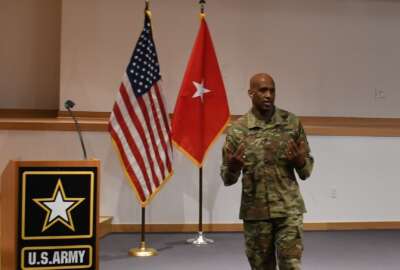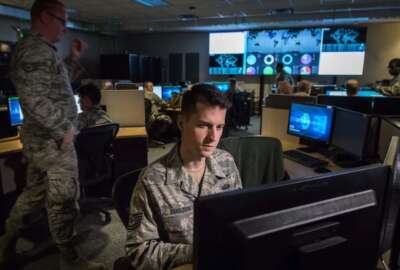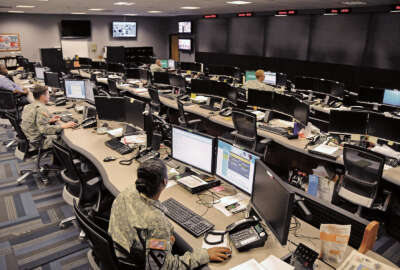Army now driving network upgrades to higher echelons
Mark Kitz, the program executive officer for the Army’s PEO-C3T, said a major priority is rethinking command posts and command and control applications.
The Army is expanding its approach to network modernization. It realized it needs to make investments at higher echelons at the division level.
Over the last 18 months, Army leaders saw how this lack of focus has created haves and have nots across the entire service.
Mark Kitz, the program executive officer for the Army’s PEO for Command, Control and Communications-Tactical (PEO-C3T), said the service is calling this pivot, the division as a unit of action.

“We have invested significant money in our network infrastructure for brigades and battalions our lower echelons of the Army. But that commiserate investment has not occurred at the higher echelons of the Army. How will our network when a division employs? How will the division employ their network? I think it’s a great opportunity for industry to now bring innovative ideas and innovative solutions now that we’re going to operate our Army very differently in a large scale combat operations (LSCO) environment,” Kitz said in an interview with Federal News Network at the recent Army TEM 13 event. “Another area that we spent a lot of time talking about this at the TEM is our modular, open system approach to how we’re doing business across our portfolio.”
Kitz said the modular open system approach will impact how commanders deploy their command posts, moving away from a one-size fits all approach with, what he called, “a bunch of tents and combat vehicles.” Instead, he said commanders have to employ their command posts in different ways, that meet their specific needs of the theater.
“We have got to get more responsive to what’s important to them, modularity, being more quiet, so they don’t get targeted. That is a big focus area for us,” he said. “We are asking industry for their innovative ideas, not just in technology, but how we would employ this? What are the unique contracting mechanisms so that I can get more responsive and not wait two years for an indefinite delivery, indefinite quantity (IDIQ) to award?”
PEO-C3T mission expanding
The second area where the Army is applying a modular, open system approach is to its command and control application infrastructure. Kitz said the need to build applications in an agile way to, again, meet the needs of the moment around where forces are or their situational awareness. This requirement is driving a lot of these changes.
The Army’s pivot to the division of the unit of action and broader recognition of the need for modular open systems comes as the PEO-C3T is expanding its mission areas.
Kitz, who took over as the program executive officer in June 2023, coming over from being the PEO for intelligence, electronic warfare and sensors (IEW&S) for two years, said the Army is reintegrating the acquisition and sustainment of the tactical and enterprise networks.
Several years ago, the Army split the two networks with C3T managing the tactical networks and the PEO-Enterprise Information Systems (PEO-EIS) managing the enterprise networks.
But Army leaders, more specifically Lt. Gen. John Morrison, the deputy chief of staff, G-6, decided a unified network would make more sense as the cloud and technologies have closed the gap between the two approaches.
The Army has been on this network consolidation and integration journey for several years, moving from 42 disparate organizational networks to now 14, and the goal is to collapse it down to one greater Army network by 2027.
Bringing tactical, enterprise networks together
To achieve that goal, the PEO-C3T is leading the Unified Network Operations (UNO) initiative to create an agile, software-defined network. In June, PEO-C3T issued a draft solicitation outlining its initial thinking around UNO.
“We are chartered to deliver the holistic network for the Army, and that presents both organizational challenges right now. I have an organization at Ft. Belvoir and at Aberdeen Proving Ground. It presents challenges across a network that was built enterprise and tactical, and so now we’ve got to find opportunities and synergies across the entire network to build one holistic network. It’s a journey that we’re just embarking on,” he said. “It is going to be a huge focus for our next TEM. What are the capabilities and opportunities that industry sees now that we’re no longer building this network in two environments? We are looking at one wholistic network. I think it’s a fantastic opportunity for industry, and it is absolutely where we’re going to go in TEM 13.”
Army TEM 13 is expected to take place this winter in Savannah, Georgia.
For the most recent industry event, Kitz said his team and other Army senor leaders ramped their meetings with contractors to focus more on programmatic outcomes.
“What we don’t get a lot of in the TEM is direct input back from industry. It’s hard to get unvarnished opinions when you’re sitting next to your competitors. That’s just a candid fact of how these industry engagements are run,” Kitz said. “So, one of the things Maj. Gen. [Jeth] Ray [the former director of the Network Cross Functional team] and I wanted to do was have that candid feedback from industry. Each one of my five program managers [ran] one-on-ones with industry. I think we had over 85 of them. Some of them are very targeted on solicitations like UNO or the modular command post. Some of them are more generic around, ‘Hey, what are the future of our radio infrastructure? Where are you investing? Where should we be investing?’ Really getting a more candid dialog with industry in a more sanitized environment where they feel more comfortable about talking about future investments. It also offers them a unique opportunity to take what they’re hearing from Army senior leaders and talk about how their investments can lead to specific outcomes.”
Kitz said these engagements help shape future Army solicitations. He credited the industry discussions at TEM 12 for helping the Army improve its initial plans for UNO.
“We significantly changed the nuance for how we were doing that UNO solicitation. Now we are doing an other transaction agreement (OTA),” he said. “We also changed the way we schedule our technical demonstrations. We originally thought we’d give them 12 months, but industry’s feedback was they only needed six months. We changed the structure of that solicitation based on industry feedback. We were able to significantly improve that RFP.”
Copyright © 2024 Federal News Network. All rights reserved. This website is not intended for users located within the European Economic Area.
Jason Miller is executive editor of Federal News Network and directs news coverage on the people, policy and programs of the federal government.
Follow @jmillerWFED







